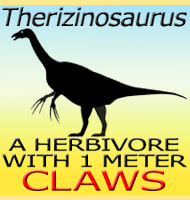Therizinosaurus
In Depth What makes Therizinosaurus and others from its group stand out from other dinosaurs are the huge claws that are on the end of its fingers. In Therizinosaurus these claws reached up to one meter long, and there purpose has three main theories. The first is for display, with the larger claws being indicative … Read more

